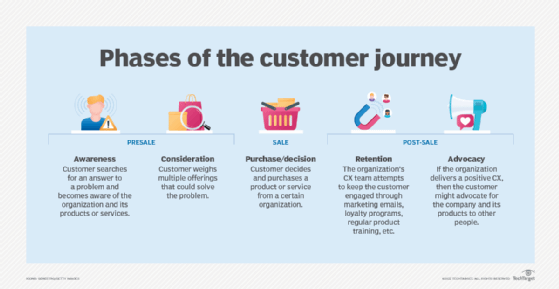What is sales motion?
A sales motion is the particular sales method an organization uses to sell and deliver a product or a service to its customers. A sales motion is a component of a product or service go-to-market strategy. It encompasses the approaches and steps a business uses to market and sell a product or service.
In the channel context, a vendor pursues indirect sales as its go-to-market strategy. At the tactical level, it uses a number of sales motions: selling through distributors and value-added resellers (VARs), for example.
A vendor uses a series of sales techniques when selling through distributors and another when selling through VARs. For instance, a sales motion with a VAR might involve jointly creating an offering that bundles some combination of products and services for customers within a vertical market. Such an offering is sometimes called a sales play. Some vendors distribute sales playbooks to their channel partners to describe how to execute the play and the sales motion associated with it.
Channel partners can develop their own sales motions for targeting certain types of customers. Overall, vendors and channel partners apply the phrase sales motion to a variety of sales activities. Other examples of sales motions found in channel sales include up-selling and cross-selling.
Why is a sales motion important?
An effective sales motion can help organizations increase revenue, close deals with new customers, enhance profitability and acquire and retain customers. By providing a structured approach to the sales process and methodology, a sales motion can align the sales cycle with a company's strategic goals while identifying pain points and any slack in the process. Alignment of goals to a sales motion is critical to growing a business.
An effective sales motion is scalable, meaning it can be replicated at scale across an organization. These scalable sales motion measures provide the following benefits:
- Increase efficiency.
- Automate tasks.
- Enable the integration and automation of workflows.
- Allow for easier performance tracking of sales activities.
The use of sales motion techniques can also build a strong brand reputation, which is a key component of customer acquisition and retention.
Sales motion components
The following components are important for maintaining a streamlined sales operation and achieving consistent sales outcomes.
Sales process
This is a structured framework that outlines the steps a salesperson or sales teams should follow from initial contact to closing a deal. A sales process is designed to be consistent and repeatable, ensuring that potential customers are approached in a systematic way to maximize efficiency and effectiveness.
Sales process stages typically include prospecting, preparing, approaching, presenting, handling objections, closing the sale and following up. A well-defined sales process supports sales reps in executing their tasks with precision and aligns their efforts with the company's strategic objectives. Sales process is also referred to as the sales pipeline.

Sales methodology
This refers to the underlying philosophy and tactics that guide the sales cycle. It's more adaptable, and focuses on the interactions and relationships with prospects. Sales methodologies vary, but they generally include customer success strategies, such as understanding customer needs and crafting tailored customer solutions, sales development, product-led sales and a positive customer experience (CX).
Customer segmentation
Customer segmentation plays a pivotal role in tailoring sales strategies to meet the unique needs of different customer groups. It involves categorizing customers based on buyer personas of shared characteristics such as demographics, geography and behavior. Once customers are segmented, businesses can target and personalize their outreach, which can lead to increased customer conversions and loyalty. Customers, or qualified leads, can also be segmented based on how lucrative their conversions would be, allowing organizations to focus their efforts based on potential revenue.
Metrics and key performance indicators
Monitoring KPIs is crucial for assessing the effectiveness of a sales motion. Metrics such as conversion rates, customer acquisition costs and customer lifetime value provide insights into the performance and health of sales activities. They help sales leaders make informed decisions, align sales efforts with business goals and improve sales strategies.
Sales motion best practices
There are several best practices for a successful sales motion. The most important include the following:
- Define clear steps. This entails setting goals and milestones for key activities, such as qualifying sales leads, demonstrating products and negotiating contracts.
- Qualify leads early. This involves using lead generation tools to focus the most sales motion effort on prospects with high potential.
- Use technology. Tools such as customer relationship management applications help streamline data management and improve customer interactions.
- Develop a compelling value proposition. Statements about value propositions should be customized to different buyer personas.
- Build prospect relationships. Personalized interactions and social media marketing let businesses engage prospects on an ongoing basis on the internet.
- Provide prospects with relevant content. Blogs, case studies and white papers build credibility by addressing common prospect concerns.
- Collaborate with the marketing team. Sales and marketing teams should work together to provide a consistent sales motion strategy and share insights to improve lead generation and nurturing.
- Continuous training. Employees require regular training and continuous learning to make sales motion techniques and functionality work.
- Performance tracking. Technology and data analysis can identify bottlenecks and track key metrics such as conversion rates and customer acquisition costs.
- Understand the buyer's journey. This includes mapping the stages of the buyer's journey in the sales funnel and its touchpoints, from awareness to decision-making, and aligning the sales motion to each stage.

Expertise in customer experience strategy is a key part of getting sales motion right. Learn some important skills CX professionals need to have.





